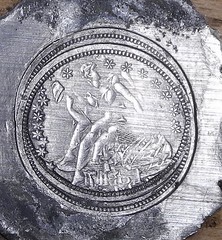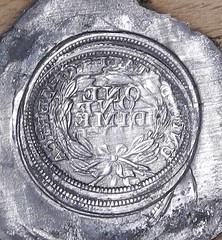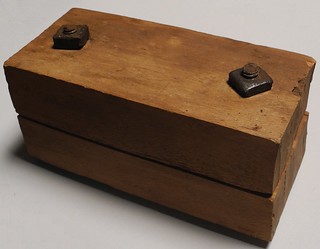
PREV ARTICLE
NEXT ARTICLE
FULL ISSUE
PREV FULL ISSUE
AN ANTIQUE COIN CURIOSITY FOUND IN A BARN
Another article by John Frost in the Summer 2015 Gobrecht Journal discusses an unusual wooden block item uncovered in an 1840s-era barn. Does anyone know what this is?
-Editor
He pulled out a plastic bag, and inside was a block of wood. Two blocks, actually, bolted together. Two pieces of hardwood, with antique bolts and hand-cut nuts. It looked like maple to me, and was clearly quite old. He told me the story… He had been going through an old barn in Cavendish, Vermont, which his family had purchased. He found the block just like this, and like me he was curious about what this could be. The nuts and bolts were just aching to be opened to see what was inside. He suggested that I do just that. So, he handed me the block, and I unscrewed the nuts. They were slightly rusty, but turned easily. When I removed both of them, I slid off the top block, and looked at what was hidden on the inside. It was two patches of lead, inlaid in each of the wood blocks, with an impression in each.

Wood block containing lead patches with impressions Upon examination, the impressions were of an 1847 Liberty Seated dime! It appeared as if a coin was sandwiched between the lead and the blocks, and then they were hammered or screwed together to impress the image of the coin into the lead. Careful examination shows multiple impressions, as though it was hammered or impressed multiple times, with the coin slightly moving between the impressions. Also clear is the fact that the dime was in high grade, perhaps nearly new, when the impressions were done. I had assumed the dime was not found inside the block. My friend said it wasn’t, and that he had searched all around the area where the block was discovered, and no dime was found anywhere on the floor, or anywhere else in the barn. The question, then, was what was the story behind this block? I told him that it was very interesting and puzzling, and thanks for showing it to me. He then asked, “Do you want this?” Continuing, he said “I really don’t have any use for this, and since I thought it was interesting, I thought you might like it.” My jaw dropped with disbelief. He knew I was always interested in unusual things Seated, so he offered it to me and I immediately agreed. It would certainly make a great exhibit item.


Impressions of 1847 Liberty Seated Dime Obverse and Reverse I had my own idea as to what this piece might have been. Plus, I have exhibited it at a number of shows this past year at LSCC tables. I put a “What am I?” sign next to it, mainly to see if other people had ideas of their own. Because it shows impressions of a coin between two molds of sorts, the first reaction of the majority of people is that it was meant to create counterfeit coins. But after pointing out that lead would not be a suitable mold for casting coins, nor were the impressions in the lead deep enough to make a three-dimensional copy, that idea was pretty-much discarded. Since the barn where the block was discovered was known to have been built in the 1840s (but no exact year is known), I wonder if this piece was meant to be a Maker’s Mark or a cornerstone of sorts. Perhaps the barn was, in fact, built in the year 1847? Since the dime was new or very close to it, it seems like a plausible explanation. Since the block can’t talk, I doubt we’ll ever know for sure how and why this interesting piece came to be, but it represents a small piece of Vermont history. I would be interested in hearing other theories. Any ideas? Please send them to me at john.frost@doubledimes.com. And look for it at a show near you!
For more information about the Liberty Seated Collectors Club, see:
The Numismatic Bibliomania Society is a non-profit organization promoting numismatic literature. See our web site at coinbooks.org. To submit items for publication in The E-Sylum, write to the Editor at this address: whomren@gmail.com To subscribe go to: https://my.binhost.com/lists/listinfo/esylum All Rights Reserved. NBS Home Page Contact the NBS webmaster 
|
